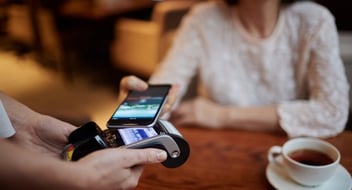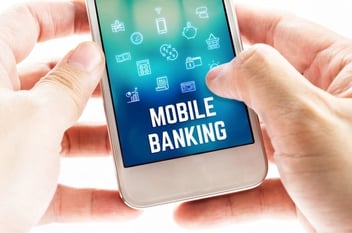The Definition of Mobile Engagement, and How to Earn It
“Mobile Engagement” is one of those terms that has come into vogue of late. There are plenty of gurus who will tell you why it’s vital, critical, essential, and other super-serious descriptors.
But what exactly is mobile engagement?
Mobile engagement is the level of interaction between a brand and consumer via a mobile device.
The interactions and engagement are closely correlated. The more frequent and valuable the interactions are, the more engaged the consumer becomes.
These mobile interactions happen through four primary channels:
Apps
A mobile application for your company or brand is the most obvious method for earning mobile engagement. At minimum, a mobile app will provide the ability to engage directly with a brand - such as making a purchase, setting an appointment, initiating a call, or requesting an appointment.
In some cases, the app is the primary business. Headspace, Spotify, and Acorns are examples of businesses built primarily around mobile apps and premium subscription tiers.
Content
This is promotional and informative material a brand produces that's consumed via mobile. It includes mobile-enabled websites, blogs, videos, infographics, and more. This content is served up through your own app, or through third parties.
It’s worth pointing out that, in most cases, content is also suitable for desktop consumption. But not all content built for desktops works well in the mobile world.
Third Parties
You don’t have to build your own app to create mobile engagement. In fact, much of the face time you earn with your audience will happen within third party structures. Social media apps like Twitter and Instagram are examples of third party apps that allow you to share content and interact with consumers. Review and discovery apps like Yelp and Foursquare also fit in this category, as do mobile coupon and commerce apps such as our own My Deals Mobile.
Basic Phone Functions
Don’t forget the “phone” part of “smartphone.” This is where phone calls and texting fall. Texting in particular is still a great way to create mobile engagement, but most people aren’t keen on unsolicited phone calls.
Why Mobile Engagement is Important
According to one report, the typical American spends a total of 41 days a year staring at their smartphone. We check them every seven minutes of our waking hours. We’re spending more time on them than with our TVs, computers, even our families in some cases.
Our lives are on these devices, and they’re our quickest connections to the outside world.
Consider all of these things that used to clutter up your house that are now contained in your pocket, ready to be accessed whenever, wherever: Alarm clocks, calculators, cameras, thermometers, world atlas, landline phones, iPods, stereo, GPS units, flashlights, wall calendars, the Encyclopedia Brittanica, dictionaries, pen and paper, voice recorders, remote controls, day planners, light switches, heart rate monitors, books, kitchen timers, and on and on and on.
In the midst of all that utility, people are connecting with brands. Over 268 billion apps will be downloaded next year, and every single one of them will have a brand behind it.
According to Salesforce.com, the number of businesses planning to use mobile marketing has doubled since 2014. Over $32 billion will be spent on mobile engagement by 2018.
Engagement is all about cutting through the clutter and making a connection. Grabbing mental real estate for the typical consumer today means making that connection through their mobile devices.
Whether you provide an everyday purchase like coffee or an occasional service such as plumbing, your next sale will be earned on more than good vibes. Besides providing a valuable experience, a smart way to earn repeat business is to get some face time in between purchases.
The coffee company can build out a loyalty program that entices people to continue purchasing so they can earn rewards. The plumbing company can text out a service reminder or an occasional discount. They could also create a video explaining how to unclog a shower drain.
The point is being accessible and reminding people about how useful your brand is. It’s doing more than just asking for another purchase, it’s building a relationship.
The Must-Haves of Mobile Engagement
So how exactly is mobile engagement earned? You don’t have to have a mobile app, though it helps. You don’t have to build content outside of your website, though that can make a big difference. Plenty of brands do well just engaging customers through social media.
It doesn’t have to be complicated, but the more value you make available to consumers, the more likely you are to draw them in.
Regardless of your specific tactic, here are eight guidelines to keep in mind when you’re pursuing mobile engagement:
1. Build everything for mobile friendliness.
Everything you create needs to look good on mobile devices. That includes your website, blog, emails, even coupons.
There are serious business reasons to do this, including protecting your Google search rankings. The bigger picture is making things simple and easy for customers to find what they’re looking for.
2. Enable push notifications
If you do choose to build an app, it’s important to convince users to enable push notifications. The vast majority of apps are deleted within a few days of being downloaded, but push notifications can stem that tide.
3. Add contextual value to your app
Enable experiences unique to the context of a smartphone. That could be sending users an alert when they’re in your area, or dropping a mobile coupon when they haven’t made a purchase in a while. For an advanced idea, the Ikea app allows users to view how certain pieces of furniture may look in their homes.
4. Make communicating simple
Enabling two-way communication is important to mobile engagement. Make it simple for people to trigger a live-chat from your site or app. Highlight your phone number and enable one-click calling.
5. Encourage opting-in
If you have a brick-and-mortar store or business, try to capture as many customers as you can before they leave. By “capture,” we mean getting them to sign up to receive texts from you, or to join your mobile loyalty program.
If those aren’t your style, then ask them to like your page on Facebook or follow you on Instagram. Even if you have to offer them a deal, it’s worth it to have that piece of real estate for ongoing engagement.
6. Encourage reviews (but be ready to respond)
For most businesses, getting reviews on sites like Yelp can be a huge boost. Ask people to review you, to snap photos of your products and upload them to the sites. It’ll be easier for others to find you when they pull open one of these apps in search of someone like you.
But this will also bring on negative reviews. Respond swiftly and fairly at all times, and even the negative reviews can become positives.
7. Enable transactions
Mobile engagement is more than asking people to make purchases, of course. But enabling that purchase to happen entirely on the device is valuable when they’re ready to buy. If you can’t enable the full transaction, consider something to make it easier. Scheduling, mobile coupons, ordering ahead, making a reservation, for example.
8. Partner where it makes sense
Is there a non-competitive business or service your customers would find valuable? Consider a mobile partnership. Examples: you can request an Uber pickup to get you to and from your Hilton hotel. You can make reservations for a restaurant through Yelp. Going back to the example of a plumber, he could partner with a carpet cleaner for a special offer after a service request is scheduled.
The possibilities are limitless due to the versatility of mobile phones. But more than keeping up with technology, mobile engagement is about exceeding expectations.
The more you can give customers that surpasses what they expect from your brand, the more engagement you’ll earn from them.
Master Your Mobile Engagement Principles to be Future-Proof
Isn’t it odd that calling and texting are so low on the mobile engagement totem pole? Just a few years ago those were still the only functions you’re mobile phone had, now they’re considered old news by many.
Just a few years from now, the tactics of mobile engagement could be completely different. Virtual reality, “glass” technology, even automated vehicles will shift how we interact with our devices.
No matter the platform, customer engagement relies upon consistent communication and value delivery. Maintain close contact with your ideal customers, and do what’s necessary to exceed their expectations.
The rules apply across the board. Always be responsive, and never abuse their trust. Build great experiences that work on any device. Make initiating contact painfully simple. Do these things, and you’ll build mobile engagement and over time, customer loyalty.
(Photo courtesy of Matthew G)
Topics: Customer Engagement, mobile engagement
Written by: Brandon Carter





.jpeg)







Share your Comment.